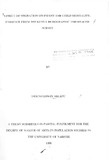| dc.description.abstract | This study seeks to establish the effect of migration on infant and child mortality in
Kenya. The data was drawn from Kenya Demographic and Health Survey, 1993. A total of
3,904 women with 5,727 children who were under-five years of age constituted the sample
size.
Specific to this study is to find out whether migration to urban areas which are
percieved to have better health-related facilities improves the chances of under-five child
survival. Thus, more emphasis has been laid on urban migrants, the other migration
typologies being used as a basis of comparison, especially rural non-migrants.
The children born in the last five years preceding the survey were the unit of
analysis. The survival chances of under-five childrer- was looked at with reference to the
socio-economic, demographic characteristics and migration status of the mother.
Analysis was done on mortality differentials using Crude Under five Mortality Rates.
Bivariate and Multivariate Logistic regression models were used to determine the
relationship, and determinants of child survival utilizing variables such as mother's marital
status and age.
The results of under five mortality differentials showed that those who migrate to
urban areas, especially rural to urban migrants, have poorer under five survival chances
compared to the urban to urban migrants . This disparity was attributed to the poor socioeconomic
conditions of the rural to urban migrants. This is a reflection of poor conditions in
their source regions.
The results also indicated poorer under five survival for urban migrants, specifically
for children of mothers with a rural childhood (survival odds' were reduced by as much as
0.9743 times those with an urban childhood). This result is significant at 0.05 level of significance. However survival odds were appreciably improved if the mother had: a higher
level of education (secondary level and above, survival odd of 5.0391 times those with a
lower or no education); a husband with a professional occupation (a higher survival odd of
1.3192); and, have a longer duration of stay of more than ten years in the urban area (higher
survival odd of .6339).
This study recommends that there should be an improvement in the provision of social
amenities especially those related to health provisions, education and clean water in the rural
areas and slum settlements. There is need to improve female education and to expand the
"Jua Kali" (informal sector) as this sector absorbs most of the rural to urban migrants. | en |

